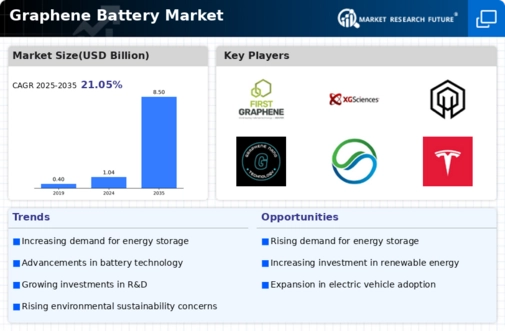Top Industry Leaders in the Graphene Battery Market
 As electric vehicles roar onto the scene and renewable energy takes center stage, one material quietly promises to revolutionize both – graphene. With its exceptional conductivity, strength, and flexibility, graphene is poised to disrupt the battery landscape. But beneath the sleek veneer of these high-performance batteries lies a fierce battleground where established players and nimble startups vie for market share amidst technological hurdles, evolving regulations, and soaring expectations. Let's navigate this electrifying arena, exploring the strategies, factors, and recent developments shaping the future of batteries.
As electric vehicles roar onto the scene and renewable energy takes center stage, one material quietly promises to revolutionize both – graphene. With its exceptional conductivity, strength, and flexibility, graphene is poised to disrupt the battery landscape. But beneath the sleek veneer of these high-performance batteries lies a fierce battleground where established players and nimble startups vie for market share amidst technological hurdles, evolving regulations, and soaring expectations. Let's navigate this electrifying arena, exploring the strategies, factors, and recent developments shaping the future of batteries.
Strategies Charging Up Market Share:
-
Material Innovation: Leading players like Samsung SDI, LG Chem, and Tesla are actively researching and developing graphene-based electrode materials with enhanced electrochemical properties. Think higher energy density, faster charging times, and improved cycle life. Early adopters of these innovations stand to gain a significant edge. -
Sustainable Focus: Environmental consciousness is influencing the market. Players are exploring sustainable and ethically sourced graphite precursors for graphene production, minimizing ecological impact and catering to eco-conscious consumers. -
Manufacturing Optimization: Scalable and cost-effective graphene production remains a challenge. Companies are investing in research and development for efficient synthesis techniques and large-scale manufacturing processes to drive down costs and improve market accessibility. -
Geographical Expansion: Asia-Pacific, with its booming electric vehicle market and government support for green technologies, presents immense growth potential. Companies like BYD and Panasonic are strategically positioning themselves in this region to capitalize on this trend.
Factors Fueling Market Growth:
-
Electric Vehicle Revolution: The rapid adoption of electric vehicles, demanding batteries with higher energy density and faster charging capabilities, is the primary driver of the Graphene Battery Market. -
Grid Energy Storage: The need for efficient and scalable energy storage solutions for renewable energy integration drives the development of long-lasting, high-power graphene batteries for grid applications. -
Consumer Electronics Trends: The demand for thin, flexible, and lightweight batteries for portable electronics like smartphones and wearables fuels the development of graphene-based solutions offering improved performance and form factor. -
Technological Advancements: Research and development efforts are leading to improved electrode designs, electrolyte optimization, and the exploration of graphene composite materials with enhanced properties. Early adopters and innovators stand to benefit significantly from these advancements.
Key Companies in the Graphene Battery market include
- Grupo Graphenano (Spain)
- SINODE SYSTEMS (U.S.)
- Graphene NanoChem (U.K)
- Angstron Materials Inc (U.S).
- XG Sciences (U.S.)
- Vorbeck Materials (U.S.)
- Graphene 3D Lab Inc (U.S.).
- NanoXplore Inc.(Canada)
- Graphene Batteries AS (Norway)
- Cambridge Nanosystems Ltd (U.K) among others
Recent Developments
-
September 2023: The US Department of Energy launches a multi-million dollar initiative to fund graphene battery research and development, further propelling market growth. -
October 2023: Samsung SDI unveils a prototype solid-state graphene battery with significantly improved energy density and fast charging capabilities, exceeding current lithium-ion battery performance. -
November 2023: A consortium of leading universities, battery manufacturers, and automotive companies launches a collaborative project to develop standardized testing protocols and performance metrics for graphene batteries, aiming to accelerate their commercialization. -
December 2023: The Graphene Battery Market exhibits cautious optimism for continued growth in 2024, driven by rising demand from electric vehicles and grid energy storage applications, technological advancements, and increased government support. However, challenges in large-scale graphene production and evolving safety regulations require careful monitoring.

